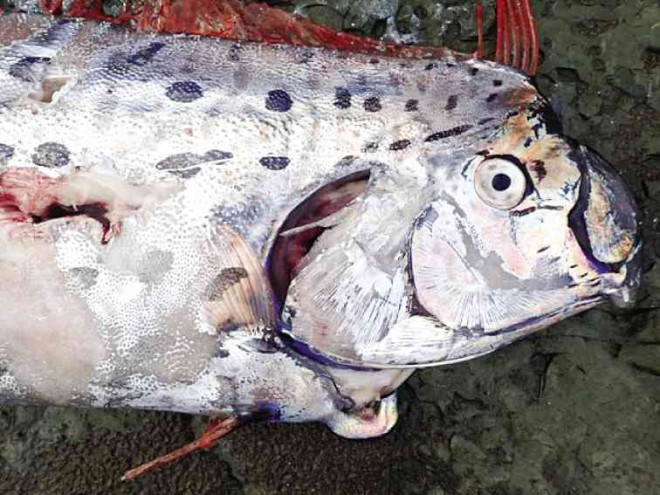
Shortly after, the shark swam off and the big fish started to float.
Miranda loaded the fish onto his boat and brought it to shore.
But the fish was no ordinary find. It was a 3-meter long oarfish weighing 14 kg.
"It was our first time to see a very big and very long fish in this town. Even the old villagers do not know the local name of this fish," said Lourdes Sarad, municipal agricultural officer of Tobias Fornier.
Oarfish, or king of herrings, was recognized by the Guinness Book of World Records as the longest bony fish to be recorded in 2015.
The longest oarfish, which was hit by a steamship, was 13.7 meters, longer than a bus.
A team of scientists in New Jersey saw in 1963 an oarfish which was about 15.2 meters long. Mature oarfish have an average length of 6 meters.
The scale-less and silvery fish is named oarfish because of their long pectoral fins, which resemble oars.
It is called the king of herrings because of their resemblance to the smaller herrings and fishes. It is also called "ribbon fish" because of its body shape and its slender, reddish fin.
What Miranda loaded onto his boat was the third oarfish caught in Antique since 2014.
On Aug. 20, 2014, Milona Alingas, agricultural technician of Laua-an town in Antique, reported an oarfish caught by fishermen.
Cornelius Yangga, agricultural technician of San Jose town also in Antique, said it was the officials' first time to encounter "the very long fish."
Yangga recalled another oarfish had been caught also in 2014. The two oarfish said to have been caught earlier had not been measured or weighed, though.
The municipal waters of Tobias Fornier is part of the Cuyo East Passage and is known as a fish migration highway.
While biologists can't explain why oarfish swim to the surface since they are deep-sea creatures, they theorize that the oarfish had been either washed to the beach by strong currents or swim to the surface to die or heal.
Dr. Romeo Caturao, dean of the College of Fisheries of the University of Antique's Tario Lim Memorial Campus in Tibiao, Antique, said the oarfish may have been carried closer to shore by a strong ocean current. Oarfish are poor swimmers that are likely to just drift with the current. Caturao said it was possible that the shark seen by Miranda chasing the oarfish had taken advantage of this.
Oarfish is caught in game fishing but is not commercially viable as food because its gelatinous flesh is considered inedible.
Rosanmi Labnao, agricultural technician in fisheries and municipal environment and natural resources of Tobias Fornier, said the town referred the oarfish to the Bureau of Fisheries and Aquatic Resources (BFAR) to determine what kind of fish it was since it was the town's first encounter with it.
"We were asked if the fish is edible or not," said Labnao. "They informed us that the fish is not palatable," he said.



Comment: This is the third report of oarfish emerging from the deep sea since April, here are the others -
Rare 17-foot-long oarfish found dead off Catalina Island, California
Rare deep sea oarfish washes up on marsh in Aramoana, New Zealand
See in addition: Rare oarfish: New Zealand sea serpent maybe a harbinger for natural disaster, says scientist